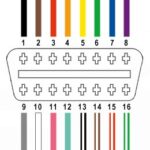When it comes to diagnosing issues or monitoring your Mazda Miata’s performance, an OBD2 scanner is an invaluable tool. However, deciding between a Bluetooth or WiFi OBD2 scanner can be confusing. This guide breaks down the key differences to help you choose the best option for your Miata.
One of the primary considerations is the type of connection. Bluetooth scanners generally offer a more energy-efficient connection, which is beneficial if you plan to leave the scanner plugged in for extended periods, such as monitoring engine temperature during drives. A WiFi connection, on the other hand, tends to drain your car’s battery more quickly.
Furthermore, Bluetooth typically establishes a faster connection with your smartphone compared to WiFi. Another significant advantage of Bluetooth scanners is that they allow your phone to maintain its internet connection while communicating with the OBD2 device. Conversely, connecting to a WiFi OBD2 scanner can sometimes prevent your phone from accessing the internet simultaneously. For quick diagnostics and removing the scanner immediately after use, a WiFi scanner might suffice. However, for prolonged use and continuous monitoring, the convenience of a Bluetooth scanner becomes much more apparent.
It’s crucial to consider smartphone compatibility. Due to Apple’s iOS Bluetooth implementation not supporting the Serial Port Protocol (SPP) used by many ELM327 Bluetooth scanners, iPhones often work more reliably with WiFi OBD2 adapters. While some older iPhones might theoretically support wired connections, these are generally impractical for most users. The common advice is Bluetooth scanners for Android devices and WiFi scanners for iPhones. Notably, some Bluetooth scanners, like the BAFX model, are explicitly labeled as “NOT iPhone/iOS Compatible,” so always verify compatibility before purchasing for your Miata if you are an iPhone user. Choosing the right OBD2 scanner ensures seamless diagnostics and monitoring for your Miata.
